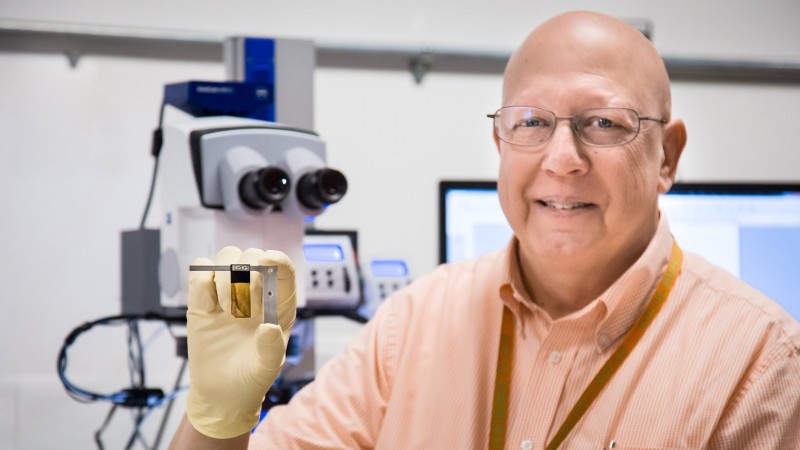It may be hard to believe that fragile, ultrathin pieces of material as light as a feather and about the size of a stick of gum could have an enormous impact on thousands of neutron experiments each year. But these specialized films, known as diamond stripper foils, play an impressive role at Oak Ridge National Laboratory’s Spallation Neutron Source.
The SNS, a Department of Energy Office of Science User Facility, could not operate without the foils, which strip electrons in a process that results in the creation of a powerful proton pulse used to produce neutrons for materials science research.
Mike Plum, accelerator physics team leader and ring area manager, explained the foil’s role. Negatively charged hydrogen ions, each containing a proton and two electrons, travel through the linear accelerator. The foil strips electrons away from the proton, depositing them in an electron collector. The remaining proton beam moves into the accumulator ring and circulates 1,000 times while new protons join the cluster.
“Imagine you have a train that’s 1,000 boxcars long,” Plum said. “If you take the first boxcar and inject it into the ring, by the time it comes back to the starting point the second boxcar comes in and goes on top of it, and then the third one comes in. So, you have taken a train that’s 1,000 boxcars long and transformed it into a train that’s one boxcar long but 1,000 boxcars tall.”
Once the spinning protons generate enough power for optimal neutron scattering, the storage ring releases an intense proton pulse to strike SNS’s mercury target, causing neutrons to “spall” off or bounce in every direction. The resulting spallation can be harnessed by funneling the neutrons into beam guides leading to specialized instruments where researchers conduct experiments to study materials.
Stripper foils allow SNS staff to manipulate the beam to minimize beam loss that wastes valuable particles and hinders the overall process.
“Instead of the beam being long and thin we want to make it short and dense,” Plum said. “The only practical way to do that is to use stripper foils.”
Because the foils play an essential role in daily operations, a superior product design and a streamlined production process are fundamentally important. Both factors require attention to detail and a continually updated approach, making production a constant learning experience.
Manufacturing takes place at the Nanofabrication Research Laboratory, or NRL, a clean-room facility at ORNL’s Center for Nanophase Materials Sciences. Benefits of this location include a close proximity to SNS and more advanced equipment, leading to increased foil output.
“These foils have unique film characteristics that give them unusually long lifetimes in relatively high beam currents, two parameters critical to the successful operation of SNS,” said Dayrl Briggs, NRL technical operations lead at CNMS.
Despite the fragility of the foils, they are capable of withstanding intense ion beam conditions. Each individual foil is very thin, measuring about 1 micrometer thick. If they were thicker, the proton beam would be significantly weakened while passing through the foil, which would complicate the process.
“Stripper foils are right on the edge of what is technologically possible,” Plum said. “They get so hot and so beat up by the beam conditions that it’s a real challenge to make our stripper foils last.”
However, the continual barrage of ion pulses is not the only threat to foil usability.
“These foils are very sensitive to any kind of air movement or mechanical shock,” said Chris Luck, who researches, rates, and recommends foils for use at SNS. “Every foil is unique, so I study each one to make sure there are no tears or other imperfections.”
The foil team was recently honored with a UT-Battelle award for the overall success of the endeavor and for its commitment to improving foil production and performance. Their foil development modernization project involved logistical changes such as obtaining a microwave chemical vapor deposition tool that was specified, built, tested and installed at NRL.
Team members include Michael Baumgartner, Michael Plum, Chris Luck, and Jeremy Price of SNS and Dayrl Briggs, Dale Hensley, Kevin Lester, Scott Retterer, Bernadeta R. Srijanto, and Leslie Wilson of CNMS. Plum also cited the crucial contributions of Robert Shaw of the lab’s Chemical Sciences Division, who led the original foil production team.
Briggs wants foils to have longer lifetimes and better reliability in the future. To achieve these goals, the team will need to better understand the diamond foil structure and performance. Furthermore, he explained, the team has run tests to ensure that new foils will be uniform, using existing films as a baseline to increase efficiency.
“The ability to process two samples at a time, in addition to doubling our throughput, allows us to install one sample in the SNS neutron beam and to study the other as a witness sample,” Briggs said. “We can then correlate performance in the beam to film characteristics.”
As the team continues to hone the foil manufacturing process at NRL, Plum anticipates further improvements in the foils because of the facility’s vast technological capabilities.
“They have some pretty advanced tools at CNMS,” Plum said. “We’ll be using those tools to figure out how to make our stripper foils even better.”
CNMS and SNS are DOE Office of Science User Facilities. UT-Battelle manages ORNL for the DOE Office of Science. The Office of Science is the single largest supporter of basic research in the United States and is working to address some of the most pressing challenges of our time. For more information, please visit http://science.energy.gov/.—by Elizabeth Rosenthal



